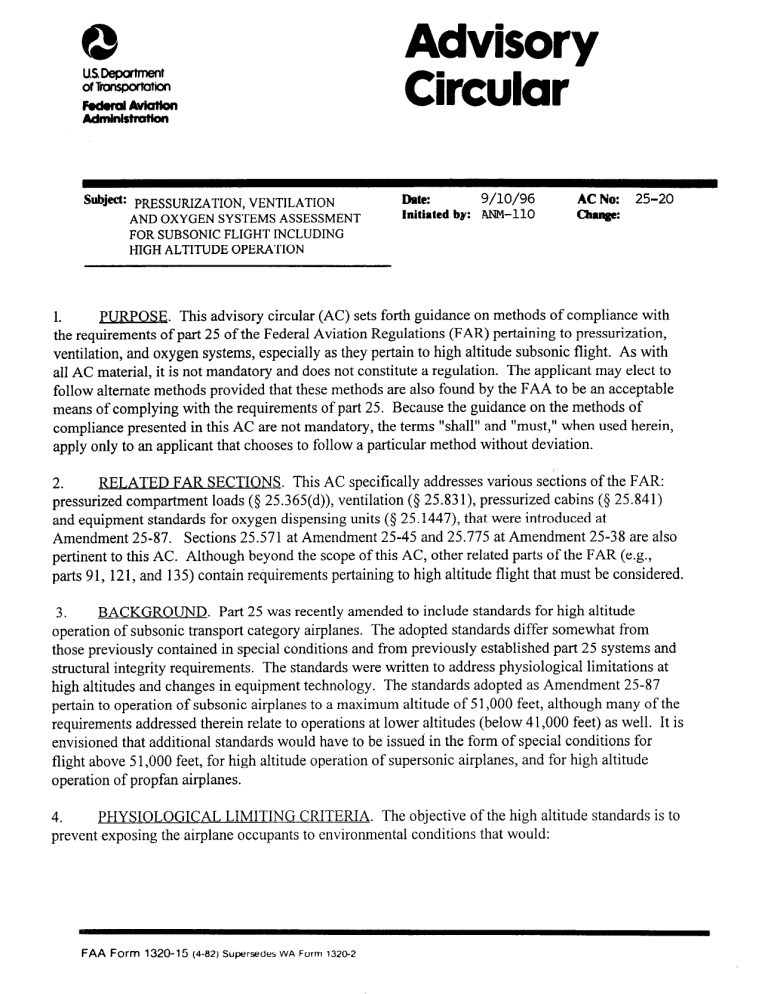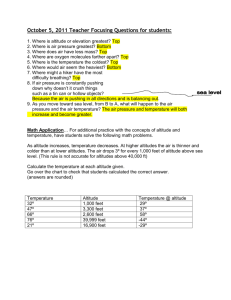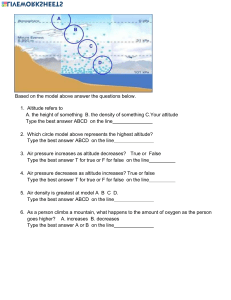Pressurization & Ventilation Systems: High Altitude Flight Guidance
advertisement

Advisory Circular 0 usDepartment d Timqmtation FOdUUlAV&t&ll AdtfthiStfUtbtl subject’ PRESSURIZATION, VENTILATION AND OXYGEN SYSTEMS ASSESSMENT FOR SUBSONIC FLIGHT INCLUDING HIGH ALTITUDE OPERATION Lhte!z Initiated by: g/10/96 ANM-110 AC No: ChJp: 25-20 PURPOSE. This advisory circular (AC) sets forth guidance on methods of compliance with 1. the requirements of part 25 of the Federal Aviation Regulations (FAR) pertaining to pressurization, ventilation, and oxygen systems, especially as they pertain to high altitude subsonic flight. As with all AC material, it is not mandatory and does not constitute a regulation. The applicant may elect to follow alternate methods provided that these methods are also found by the FAA to be an acceptable means of complying with the requirements of part 25. Because the guidance on the methods of compliance presented in this AC are not mandatory, the terms “shall” and “must,” when used herein, apply only to an applicant that chooses to follow a particular method without deviation. RELATED FAR SECTIONS. This AC specifically addresses various sections of the FAR: 2. pressurized compartment loads (0 25.365(d)), ventilation (6 25.831), pressurized cabins (4 25.841) and equipment standards for oxygen dispensing units (5 25.1447), that were introduced at Amendment 25-87. Sections 25.571 at Amendment 25-45 and 25.775 at Amendment 25-38 are also pertinent to this AC. Although beyond the scope of this AC, other related parts of the FAR (e.g., parts 9 1, 12 1, and 135) contain requirements pertaining to high altitude flight that must be considered. BACKGROUND. Part 25 was recently amended to include standards for high altitude 3. operation of subsonic transport category airplanes. The adopted standards differ somewhat from those previously contained in special conditions and from previously established part 25 systems and structural integrity requirements. The standards were written to address physiological limitations at high altitudes and changes in equipment technology. The standards adopted as Amendment 25-87 pertain to operation of subsonic airplanes to a maximum altitude of 5 1,000 feet, although many of the requirements addressed therein relate to operations at lower altitudes (below 4 1,000 feet) as well. It is envisioned that additional standards would have to be issued in the form of special conditions for flight above 5 1,000 feet, for high altitude operation of supersonic airplanes, and for high altitude operation of propfan airplanes. PHYSIOLOGICAL LIMITING CRITERIA. The objective of the high altitude standards is to prevent exposing the airplane occupants to environmental conditions that would: 4. FAA Form 1320-15 (4-82) Supersedes WA Form 1320-2 AC 25-20 5. 9/l O/96 a. Preventthe flightcrew from safely flying and safely landingthe airplane,or b. Causepermanentphysiologicaldamageto the occupants. VENTIT #ATION. a. Section25.831(a) specifiesthat the ventilation systemmust be designedto provide a minimum of 0.55 poundsof fresh air per minute per person(10 cubic feet per minute of air at 8,000 feet pressurealtitude and at cabin temperatureof 75” F.) for normal operations. If the airplane incorporatesa recirculation system,the requiredfresh air may be mixed with filtered, recirculatedair. A larger amount of fresh air may be requireddueto secondaryconsiderations,suchasequipment cooling, window or windshield defogging,control of smokeor toxic fumes, or smokeevacuation. Increasedfresh air flow may also be neededin someinstancesto compensatefor high ambient temperaturesand humidity. The massflow following probablefailures is addressedin paragraph5.e of this AC. b. Compliancewith theserequirementsmay be demonstratedby analysis,ground tests, and/or flight tests. Becauseit is not practicableto measurethe air flow at eachoccupant’slocation, the fresh air suppliedper minute per occupantmay be determinedby averagingthe total cabin fresh air supply and cockpit fresh air supplyfor the numberof occupantsthat eachareacan accommodate. The environmentalsystemsshouldbe investigatedfor the extremesof the airplane operatingenvelope. Tests (component,sub-system,airplane)and/or analysisshouldbe usedto establishthe capabilitiesof the environmentalsystemsat temperaturesanticipatedto be encountered in service. For informational purposes,guidelinesfor climatic extremesmay be found in Reference 1, “Military StandardClimatic Extremesfor Military Equipment,” MIL-STD-2 1OB. C. d. Takeoff with the air conditioningor bleedair system “off’ may be an acceptable procedureprovided the ventilation systemcontinuesto provide an acceptableenvironmentin the passengercabin and cockpit for the brief period when the ventilation systemis not operating normally. e. For probablefailure conditions,the ventilation systemshouldbe designedto provide enoughfresh air to prevent the accumulationof odorsand pollutants suchas carbondioxide. Under theseconditions, the supply of fresh air shouldnot be lessthan 0.4 poundsof fresh air per minute per occupantfor any period exceedingfive minutes. This value also appearsin advisory material usedby the Joint Aviation Authorities to establisha minimum flow rate following loss of oneair source. Temporaryreductionsbelow this flow rate may be acceptableprovided the compartmentenvironment is maintainedat a level which is not hazardousto occupants. This value is basedon the minimum airflow for nonsmokingoccupiedspacesrecommendedin the ASHRAE 62-1981 standard(the American Societyof Heating, Refrigerating, and Air-Conditioning Engineers,Inc.). In addition, 2 Par 4 9/l O/96 AC 25-20 equipmentcooling and ventilation for smoke evacuationshould be provided following such failure conditions. The conditions to be consideredshould include failures of componentssuch as fans, valves,and ducts, failures of a single air conditioning system or bleed air system,and failures of dual air conditioning systemsor dual bleedair systemswhen the systemshave common control systems, duct inlet systems,or distribution systems. The purposeof the exposuretime-temperaturelimitation graph of $ 25.83l(g) is to f. ensurethat emergencypressurizationmeans,suchas the use of high temperatureair, do not expose ’ airplaneoccupantsto unsafecabin air temperaturesfollowing failures of the normal pressurization system. 140’ 140°F A T1 lOOoF F T1 A 1 i Failure Time 100°F Time The graph of $25.831(g) is to be usedas follows: The left plot aboverepresentsthe mean cabin temperature(failure temperature)plotted againstthe time after failure. The right plot is the exposure time-temperaturelimiting graph of $25.83 1(g). Any delaysin descentfor corrective action or due to operationalrestrictions shouldbe includedin the establishmentof the failure temperaturecurve. The time at any given temperaturefrom the left plot is not to exceedthe time at the sametemperatureof the exposuretime-temperaturelimiting graph. For example,time “A” at temperatureT1 should always be lessthan or equalto time “B” at the sametemperatureas checkedfor eachtemperature from 100” F. to 140” F. 6. PRESSURIZATION. a. Sections25.841(a) and 25.1447(c) are intendedto ensurethat, following a failure or combinationof failures leadingto a decompressionat the maximum certificated altitude: (1) Par 5 The flightcrew will remain alert and able to safely fly and land the airplane; AC 25-20 9/l O/96 (2) Occupantsof the cabinwill be protectedfrom the effects of hypoxia (see Glossary); and In the event someoccupantsdo not receivesupplementaloxygen, they neverthelesswill not suffer permanentphysiological(brain) damage. (3) b. Section25.841(a)(l) is intendedto prevent exposingthe airplaneoccupantsto extreme environmentalconditions resulting from probablefailures; however, emergencydescentprocedures are allowed to be usedto meet this requirement. Complianceshouldbe demonstratedby airplane flight tests for the probablefailure condition having the most severeeffect, starting at the maximum airplanealtitude and, when necessary,using emergencydescentprocedures. C. Typical probablepressurizationfailures, similar to ventilation failures, are failures of a single air conditioning systembleedair system, failures of dual air conditioning systemsor dual bleed air systemswhen the systemshave common control systems,or other similar single failures. Other probablefailure conditionsthat should be consideredinvolve failures in the outflow valve control or the outflow valve itself. d. Section25.841(a)(2)(i) was basedon the conceptof “Time of SafeUnconsciousness” documentedby JamesG. Gaume(seeReference2). It is recognizedthat the useof passenger continuousflow oxygen masksfollowing rapid decompressionto cabin altitudes above34,000 feet may fail to provide protection from hypoxia (seeGlossary). It is also recognizedthat some passengerscould be exposedto decompressionwithout oxygen. A few may lose consciousnessat 35,000 feet; and others, evenwith the useof continuousflow oxygen equipment,may lose consciousnessat greateraltitudes. Exposureto cabin altitudes in excessof 25,000 feet for more than 2 minutes without supplementaloxygen could in somecasescausepermanentphysiological (brain) damage. Complianceshouldbe demonstratedby calculatingthe cabin decompressionprofile using the critical hole size(s) and location, emergencyprocedures,and a demonstratedemergencydescent profile. Seethe examplein Paragraph10, EmergencyDescent. Section25.841(a)(2)(ii) specifiesthat occupantsmust not be exposedto a cabin e. altitude greater than 40,000 feet after decompression.Oxygen systemscannotprotect againstall of the effects of decompression,which becomemore critical at higher altitudes (seeReference3). Complianceis demonstratedby calculatingthe cabin decompressionprofile using the critical hole size(s)and location, emergencyprocedures,and a demonstratedemergencydescentprofile. Seethe examplein Paragraph10, EmergencyDescent. 7. FAILURE CONDITIONS. Section25.841(a)(3) describesthe conditions and failures that shouldbe consideredin evaluatingcabin decompression.Possiblemodesof failure, including malfunctions and damagefrom external sourcessuch astire burst, wheel failure, enginerotor burst, Par 6 9/l O/96 AC 25-20 enginefan failure, uncontainedenginebladefailure, loss of antennas,etc., areto be considered. Sections25.1309and 25.571, togetherwith their associatedAC’s, provide guidancein determining definitions of reliability and additionalsourcesof failure. AC 20-128A provides guidancefor addressingthe hazardsassociatedwith uncontainedturbine engineand APU rotor failure. Considerationshouldbe given to systemfailures (both latent and active failures), combinationsof systemfailures, system failure combinedwith leaksin the pressurevessel(normal and failed seals), failures causingengineshutdown,enginefailures causingstructural and system damage,structural failures, etc. Typical systemsto be consideredare enginebleedair systems,air conditioning systems, power sources,outflow valves and their associatedcontrol systems,etc. Failuresor a combinationof failureswhich exposethe occupantsto: (1) cabin altitudesin excessof either 25,000 feet for more than 2 minutes, or (2) cabin altitudesthat exceed40,000feet for any duration, shall be shown to be extremely improbable(seeGlossary). 8. FUSELAGE STRUCTURE. a. Higher operationalaltitudescould make the loss of cabinpressuredue to fuselageskin crackscatastrophiceventhough the structure remainscapableof supportingflight loads. Therefore, pressure-loadedstructuresfor high altitude operationshouldbe designedto be more reliablethan thoseof presentairplanes. Additional damage-tolerance requirementsare necessaryto prevent fatigue and corrosiondamagewhich could result in a rapid depressurization. The cabin altitude/time history shouldnot exceedthe limitations of 5 25.841(a) after b. the maximum pressurevesselopeningresulting from an initially detectablecrack propagatingfor a period encompassingfour normal inspectionintervals. Cracksthrough skin-stringer and skin-frame combinationsshouldbe considered. A higher level of structural integrity in the pressurevesselis necessaryfor high altitude operations. Pressurevesselopeningsresulting from discretesourcedamage(9 25.571(e))such as a tire burst, wheel failure, enginerotor burst, loss of antenna,etc., or any equipmentfailure which could result in damageto the pressurevessel,should be analyzedto determineeffects on pressurization while operatingat maximum cabin differential pressure. C. The total loss of a window or windshield shouldbe assumedunlessit can be shown d. that total loss is extremely improbable,due to either fatigue failure or to its location with respectto likely sourcesof damage. Section25.775 requiresthat windshieldsand windows be fail-safe; therefore, total loss of a window dueto fatigue failure may be consideredextremely improbableif the window is designedfail-safe and capableof withstandingfull cabinpressurein conjunctionwith externalaerodynamicpressurewith a factor of safety of: 1.5 for the primary panelaloneand 1.15for the fail-safe panel alonefor airplanesapprovedfor pressurealtitudesup to 45,000 feet; or (1) Par 7 5 AC 25-20 9110196 (2) 1.5 for both the primary andfail-safe panelsalonefor airplanesapprovedfor pressurealtitudesabove45,000feet. Considerationshouldbe given to pressurevesselstructural failures (holesor cracks) e. that may occur in areasof negativepressuredifferential, becausethis condition may causethe cabin altitude to exceedthe airplanealtitude. In calculatingthe cabinaltitude decompressionprofile, unlessa different value canbe f. establishedby a rational analysisacceptableto the FAA, an orifice dischargecoefficient of Cd = 0.75 for loss of a window and Cd = 0.5 for a hole resultingfrom fuselagedamageshouldbe assumed. 9. ENGINES. a. Enginerotor burst (including fan, compressorand turbine blades,and rotor disc) and completeloss of thrust from all enginesshouldbe considered.Multiple enginefailures haveoccurred dueto parallel failure effects, secondaryeffects, and operationalerrors. Engine,multiple fan blade, . and rotor disc failures have occurredat cruiseconditionsandhave causeddecompression.Basedon serviceexperience,it must be assumedthat thesefailures will occur. Airplane decompressioncausedby uncontainedenginefailure hasbeenexperienced; b. however, decompressionsthat have occurredhavebeenat flight levelswhere oxygen equipment provided adequateprotection and the servicehistory hasbeenacceptable.Becauseservicehistory on existing enginesis not usually applicableto new engines,the benefits of this servicehistory are limited. Uncontainedenginefailure is more likely to occur during takeoff and climb; however, approximately20 percentof thesefailures occur in cruise,discountingbird strikes. An engineburst at cruisecondition must thereforebe consideredand damageassessmentrelative to depressurization shouldbe conducted. It hasbeentraditional to basedamageassessments andthe failure modesandeffects on uncontainedenginerotor burstsusing the classictri-hub burst (l/3 rotor segment)model. This was, and still is, appropriateconsideringthe energiesin rotor failures. However, with the introduction of the high bypassratio fan engines,fan failures can be the dominant factor in estimating fuselagedamagehole sizes. Damagedueto uncontainedenginefan bladesand rotor fragments shouldbe consideredto occur in a zonebetween15 degreesforward of the fan planeto 15 degreesaft of the last turbine stageplane. Guidanceon enginefragment sizesanddispersionanglesmay be found in AC 20-128A. C. d. An inner fuselagetangentialstrike is assumed.If windows are within a projected strike zoneof 15 degreesforward or 15 or more degreesaft of the planeof rotation, usethe areaof window(s) unlessareaof the tangentialslice dueto a rotor fragment determinedin accordancewith AC 20-128A is greater,in which casethe areaof the tangentialslice shouldbe used. 6 Par 8 9/l O/96 AC 25-20 e. Project a scenarioof destruction,an inner fuselagetangentialslice. Typical, but not the only tangentialprojection possible. L can be assumedto be the sector distance(i.e., straight line). X is the enginefragment dimensionobtainedfrom AC 20-128A. f. Propeller fans (propfans or unductedfans) may be consideredin an amendmentto this AC. 10. EMERGENCY DESCENT In demonstratingcompliancewith $25.841, it shouldbe assumedthat the oxygen a. equipmentis being usedabovean airplaneoperationalaltitude of 41,000 feet and that an emergency descentis madein accordancewith an approvedemergencyprocedure. Crew recognition time for decompressionand oxygen mask donningtime should be appliedbetweenthe cabin altitude warning andthe beginningof action for descent. The probablesystemfailure having the most severeeffect shouldbe demonstratedby flight test at the maximum airplanealtitude. For improbablefailures, the cabin altitude should be establishedby an analysiswhich is verified, if necessary,by tests conducted at a lower altitude. A 17-seconddelay after decompressionfor crew recognitionand oxygen mask b. donningtime shouldbe appliedbetweencabin altitude warning and initiation of action to configure for descent. The 17-secondreaction time was originally basedon meanvaluesof emergency responseson simulators in terms of air crew responsesin a given emergencysituation, where there par 9 7 AC 25-20 9/l O/96 would actually be pressure loss or some other emergency situation. The 17-seconds is a value that represents the 75th percentile of crew reactions. (Information from Physiological Requirements by Dr. E.G. Vail, WADC, United States Air Force (USAF) - Presented at a USAF symposium on high altitude oxygen requirements in May 1956) Reaction times were further studied by Bennett (see Reference 4). Forty-two pilots were exposed to airplane decompression for an overall cabin rate of climb of 30,000 feet per minute to a maximum cabin altitude of 30,000 feet. Eighty-three percent of the pilots donned the oxygen mask in 15 seconds. Emergency descent was initiated in all cases within 5 seconds of the fitting of the mask. The following example of a pressurization failure should make clear the use of delays and environmental limitations. C. Assumption and definitions: 8,000 feet normally. HN = The normal cabin pressure altitude which is less than or equal to HA = Airplane altitude. Tf = Time of pressurization failure. TW = Time of the 10,000 foot cabin pressure altitude warning. Tl = Time that the airplane descent begins. TR = Recognition time for crew response to emergency annunciation (17 seconds). TS = Time for trouble-shooting or damage assessment; for example, switching the outflow valve to “manual” to attempt to regain cabin altitude control. TD = Time to configure the airplane for descent; for example, gear extension. Tl -TW = Delay time from cabin altitude warning to time that the airplane begins to descend =TR+TS+TD. 8 Par 10 9/l O/96 AC 25-20 Altitude -Feet- 40,000 k - - - - - - - h - - - - Maximum Cabin Altitude Allowed 25,000 This elapsed time shall not exceed two minutes. Cabin Altitude 8,000 5,000 I D-1 feet Ilhe The time for trouble-shooting and time to achievedescentconfiguration may be based d. on analysisand simulation. Once the critical failures have beenselected,thesedelays should be evaluatedto verify that the descentrate is one whicha typical operating crew can achieve. The descentrate establishedshould be reflected in the flight manual proceduresand the flight manual should also recommend descendingto 5,000 feet if practical when operation exceeds35,000 feet. See Reference2, page 385. The limitations of 0 25.841(a)(2) are not intended to be usedin calculating the quantity of oxygen that is neededfor emergencydescentand sustenance.The flightcrew may inadvertently, or by intent, delay descentfor any number of reasons. Different descentrates may be established. The operating rules specify the quantity of oxygen that must be carried. e. OXYGEN EQUIPMENT. Both diluter demandand pressuredemandoxygen equipment (see 11. Glossary) have proven to be satisfactory for useup to cabin pressurealtitudes of 40,000 feet when the personusing the oxygen equipment is exposedto a gradual altitude rate of climb. The oxygen equipmentrequired by Amendment 25-87 will provide protection againstthe effects of hypoxia for the cabin altitudes allowed under the new requirements. 12. GLOSSARY. PhvsiologicalAltitude Limits.. The responseof human beings to increasedaltitude varies with the individual. Peoplethat smoke or are in poor health will be affected at a much lower altitude than people who are young and in good physical condition. Without supplementaryoxygen, most people will begin to experiencea reduction in night vision or generalvisual acuity at approximately 5,000 Par 10 AC 25-20 9/10/96 feet altitude. At an altitude of approximately 10,000 feet, a person will begin to display measurable deterioration in mental abilities and physical dexterity after a period of several hours. At 18,000 feet, the mental deterioration may result in unconsciousness, and the time of useful consciousness (TUC) is generally about 15 minutes. At 25,000 feet, the TUC for most people is about 3-10 minutes. At altitudes above 25,000 feet, the TUC decreases very rapidly, becoming only a few seconds at 40,000 feet. If a person is breathing 100 percent oxygen, however, the partial pressure of oxygen in the lungs at 34,000 feet altitude is the same as that for a person breathing air at sea level. At 40,000 feet, a person breathing 100 percent oxygen will have the same partial pressure of oxygen in the lungs as a person breathing air at 10,000 feet. Therefore, 34,000 feet is the highest altitude at which a person would be provided complete protection from the effects of hypoxia, and 40,000 feet is the highest altitude at which 100 percent oxygen will provide reasonable protection for the limited period of time needed to descend to a safe altitude. Hvnoxia. Hypoxia is an insufficient supply of oxygen. Hypoxia results from the reduced oxygen partial pressure in the inspired air caused by the decrease in barometric pressure with increasing altitude. Diluter Demand Oxygen System. A flightcrew oxygen system consisting of a close-fitting mask with a regulator that supplies a flow of oxygen dependent upon cabin altitude. Regulators approved for use up to 40,000 feet are designed to provide zero percent cylinder oxygen and 100 percent cabin air at cabin altitudes of 8,000 feet or less, with the ratio changing to 100 percent oxygen and zero percent cabin air at approximately 34,000 feet cabin altitude. Regulators approved up to 45,000 feet are designed to provide forty percent cylinder oxygen and 60 percent cabin air at lower altitudes, with the ratio changing to 100 percent at the higher altitude. Oxygen is supplied only when the user inhales, reducing the amount of oxygen that is required. Pressure Demand Oxygen System. Similar to diluter demand equipment, except that oxygen is supplied to the mask under pressure at cabin altitudes above approximately 34,000 feet. This pressurized supply of oxygen provides some additional protection against hypoxia at altitudes up to 40,000 feet. Pressure Demand Mask with Mask-Mounted Regulator, A pressure demand mask with the regulator attached directly to the mask, rather than mounted on the instrument panel or other area within the flight deck. The mask-mounted regulator eliminates the problem of a long hose which must be purged of air before 100 percent oxygen begins flowing into the mask. Continuous Flow Oxygen Svstem. The oxygen system usually provided for passengers. The passenger mask typically has a reservoir bag, which collects oxygen from the continuous flow oxygen system during the time when the mask user is exhaling. The oxygen collected in the reservoir bag allows a higher inspiratory flow rate during the inhalation cycle, which reduces the amount of air dilution. Ambient air is added to the supplied oxygen during inhalation after the reservoir bag oxygen supply is depleted. The exhaled air is released to the cabin. 10 Par 12 9/l O/96 AC 25-20 ProbableFailures. Probablefailures may be expectedto occur severaltimes during the operational life of eachairplane. The probability of occurrenceis on the order of 1 x 10e5or greater(see Advisory Circular 25.1309-l A). The consequences of the failure or the requiredcorrective action may not significantly impact the safety of the airplaneor the ability of the crew to copewith adverseoperating conditions. ImprobableFailures, Improbablefailures are not expectedto occur during the total operationallife of a random singleairplaneof a particulartype, ,but may occur during the total operationallife of all airplanesof a particular type. The probability of occurrenceis on the order of 1 x 10m5or less,but of the failure or the requiredcorrective action must not greaterthan 1 x 10-9. The consequences preventthe continuedsafeflight and landing of the airplane. E1 Extremely improbablefailures are so unlikely that they neednot be consideredto ever occur, unlessengineeringjudgment would requiretheir consideration. The probability of occurrenceis on the order of 1 x 10m9or less. This categoryincludesfailures or combinationsof failures that would preventthe continuedsafeflight and landing of the airplane. 13. REFERENCES. a. Reference1. “Military StandardClimatic Extremesfor Military Equipment, MIL-STD-2 1OB.I’ b. Reference2. “Factors Influencing the Time of SafeUnconsciousness(TSU) for CommercialJet Passengers Following Cabin Decompression”by JamesG. Gaume,Aerospace Medicine, April 1970. C. Reference3. AerospaceInformation Report (AIR) No. 822 and 825A (Physiology Section);SAE Committee A-l 0. Reference4. “ReactionsandPerformanceof Pilots Following Decompressionby G. d. Bennett,AerosnaceMedicine, February 1964. 14. FOR FURTHER READING. a. Prevention. b. Par 12 AC 20-32B, CarbonMonoxide (CO) Contaminationin Aircraft - Detection and AC 91-8B, Use of Oxygen by Aviation Pilots/Passengers. 11 AC 25- 20 9/l O/96 d. BioastronauticsData Book, NASA SP-3006,National Aeronauticsand Space Administration. An Analysisof the OxygenProtectionProblemat Flight Altitudes Between40,000 and e. 50,000 Feet, FinalReport, Contract FA-955, by W. V. Blockley andD. T. Hanifan. RONALD T. WOJNAR Manager, Transport AirplaneDirectorate Aircraft Certification Service,ANM- 100 12 Par 14



